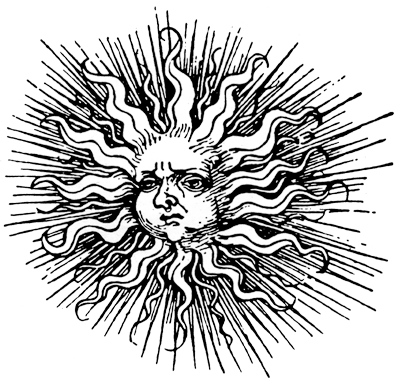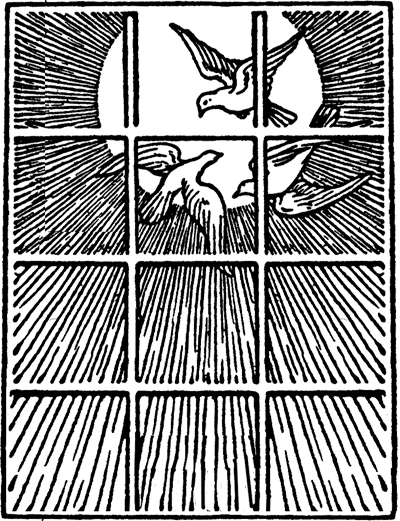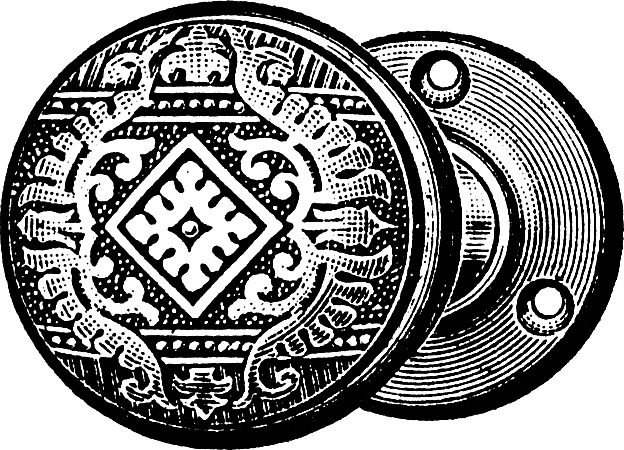“Six Questions About the Sun” by Brian Conn June 7, 2006 – Posted in: Fiction, Free Content, Sybil's Garage
Six Questions About the Sun
by Brian Conn
to the sound of Pelikanol by Einstürzende Neubauten…
As Published in Sybil’s Garage No. 3
 Q: Are fish afraid of the sun?
Q: Are fish afraid of the sun?
A: Yes. Fish, like all creatures, are afraid of the sun. Some fish never see the sun, but they, along with other creatures that never see the sun (nocturnal insects, creatures that live underground) nevertheless know darkness and light, heat and cold. As a creature contemplates its relationship with heat and light, it becomes aware that, although heat and light sustain it, heat and light also sustain its enemies and surround it with movement, noise, and danger. If fish fear the sun less than other creatures, it is because, deep in the sea, the creatures of the sun may appear to be creatures of darkness. Fish, finding themselves among so many blind creatures, cold creatures, and creatures that draw their sustenance from hot rifts in the earth, may err and suppose it is the darkness that sustains their enemies, but in fact their enemies are sustained by the sun.
There is a story that Tariq the Cosmonaut conceived what was to be his final voyage while walking on a mountain trail at dusk. On the trail he was surrounded by the sun’s creatures: tall trees, nodding ferns, animals rustling in the grasses. He became aware abruptly of the shadows that lay all around him. A root reached from the hillside like a claw. Tariq became afraid. He knew that every creature was created by the sun, and he wondered: Why does the sun create so many creatures and then abandon us to them in the dark? He realized that, although the sun sustains us, it is not our friend, for it is the sun that surrounds us with movement, noise, and danger. He resolved then that his next voyage would take him to the sun.
 Q: Should you look directly into the sun?
Q: Should you look directly into the sun?
A: Yes. Everybody should look directly into the sun at least once. It is not necessary to look directly into the sun regularly, because it is possible to remember the experience after looking there only once; but if you ever forget what it is like to look directly into the sun, you should look there again.
We are all creatures of the sun. Although it is not correct to say that we are part of the sun, the heat and light that sustains us and nourishes our food comes from the sun, and all the heat and light that is in us was once in the sun. Therefore, if we want to know ourselves, we must look directly into the sun.
When Tariq the Cosmonaut set out for the sun, he discovered that the experience of looking directly into the sun changes as one’s distance from the sun changes. Once he had gone half the distance to the sun, he described in his daily radio broadcast how he beheld there a variety of colors in constant motion. When he had gone three-fourths of the distance, these colors faded and the sun appeared to him as a fiery mandala in orange and black. When he had gone seven-eights of the distance, the patterns of the mandala faded, and sun no longer seemed to be a flat disc, as we see it, but rather concave, as an immense retina, across which floated countless dark motes which seemed as he approached to whisper to him with a hissing noise. Yet this perception also faded as he drew nearer to the sun.
We must remember, when looking directly into the sun, that the way we see it is not the only way, for our distance from it is fixed. Although it is important for us to develop the best image of the sun we can, we must not become attached to this image, thinking it is the only one. It is for this reason that we should not look too often directly into the sun, fixing its image repeatedly in our minds, but rather, having looked there once, endeavor to remember what we saw.
A: Yes. The sun most often kills with poison. When Tariq the Cosmonaut landed on the sun, he found every kind of poison known to him and hundreds more, stored in rubber balloons hanging in a row from the ceiling of a long, narrow warehouse. Most of the time the thick walls of the warehouse shaded the poisons from the heat of the sun, but in each of the two long walls was a row of hatches, one pair of hatches to each balloon, and these opened and closed at unpredictable intervals. When the hatches before and behind a balloon opened, the intense heat of the sun caused a small amount of the poison in the balloon to turn to vapor and escape through a brass valve near its top, and the solar wind sent the vapor hurtling in the direction of the earth.
Although it is best to protect ourselves by keeping away from the sun’s rays and purifying our food before we eat it, scientists now believe that, whatever precautions we take, we will inevitably be exposed to small amounts of the sun’s poisons. It is to recover from these poisons that we sleep at night. Those who remain indoors and eat only food that has been carefully purified need only one to two hours of sleep; for most of us, however, this level of protection is impossible, and we must be sure to sleep every night until our bodies are fresh. As long as we do this, we can remain healthy, but if we remain awake too long, exposing ourselves and our food to the sun, the sun may kill us.
 Q: How does the sun keep burning?
Q: How does the sun keep burning?
A: The sun must have its supply of fuel continually replenished.
After landing on the sun, Tariq the Cosmonaut noticed that, although the temperature there far surpassed even the hottest temperatures on earth, he seemed to sweat only very little. Sealing his ship at night, however, he began to sweat profusely. He opened the ship’s door, but stretched a fine adhesive net across the opening, sealing its edges. This experiment produced immediate results: there appeared in the net a great number of white birds, each as small as a thumbnail and having a peculiar beak, pouched like a pelican’s and terminating in a bony funnel.
Scientists now believe that millions of these birds fly between the sun and the earth every day, although there are never so many here as Tariq found on the sun. They are so small and their speed so great that they cannot be detected except by sealing a room with an adhesive net, yet they surround us whenever we are outdoors, and their adroitness is such that they are able, without alerting us to their presence, to collect our sweat, tears, saliva, and blood, which they carry in their beaks to the sun, to be its fuel. This is the reason why we seem to sweat more profusely in a closed room: the birds of the sun are able to penetrate only in small numbers, and thus carry the sweat away more slowly, causing it to linger on our skin.
Although it is difficult to estimate what quantity of this fuel the sun consumes, it must be a very great quantity, and Tariq discovered no reserve of fuel on the sun. Many people believe that, were we to take all the creatures of the sun into our homes, and seal our doors and windows, and lie still for one day, or even for one hour, the sun would consume all its available fuel and expire.
Q: What does the sun want?
A: Nobody knows for certain what the sun wants. Its actions seem contradictory: it sustains us yet also sustains our enemies; comforts us yet abandons us; nourishes our food yet poisons us.
Some thinkers have proposed that what the sun wants is a state of darkness, coolness, and peace. Its urge, they say, is to expend itself in a frenzy of meaningless creation and destruction. What it wants is not precisely death, for nothing prevents it from directing its poisons at the birds that bring it fuel, and so destroying itself. No, it yearns rather for the bottom of the sea, where the salty water of life surrounds it, yet where only the most solitary creatures go, where movement and noise are minimal, and where the possibilities for achieving peace amidst life seem greatest. But without the sun the stuff of life would not last even at the bottom of the sea; therefore, the sun must first find a way to shift the burden of sustaining life to a new sun, and only afterwards retire into the sea.
Tariq the Cosmonaut discovered, in a locked brass chest near the center of the sun, a set of blueprints. Although he was a skilled reader of every kind of map and chart, these were of surpassing complexity. He studied them for seven days, during which his radio broadcasts ceased entirely. At last he came to believe that they were the blueprints for the sun, written in an alien hand. He concluded that our sun was not the first, but rather had been created by the creatures of a previous sun in order to allow their sun to realize its desire and shift away its burden of sustaining life. He thought it likely that this previous sun, along with any number of yet earlier suns, now lay dark and peaceful at the bottom of the sea, and he intended on his next voyage to explore not the bright stars of the sky but the dead stars under the sea.
Q: Are there doors on the sun?
A: There are now two doors on the sun. The first of these is made of solid brass and measures seven fathoms tall, three fathoms wide, and one fathom thick. It stands at the center of the sun, and its brass handle scorches and melts anything that it touches. In the last radio broadcast of Tariq the Cosmonaut, he explained a scheme for converting a part of his ship into a tremendous vacuum pump and opening this door by suction. Many people believe that Tariq’s luck ran out with this scheme, and he perished; but many others believe that he passed alive through the door of the sun and may yet return from a strange place.
The second door on the sun is the door of Tariq’s ship. Scientists still receive signals from the ship’s radio beacon, suggesting that it remains on the sun; however, nobody has yet recovered it. Some people are glad that, although nobody else has reached the sun, there is at least one door there the size of doors on earth. They urge their governments to send more ships, more people, more doors, walls, and roofs, and they look forward to a time when the sun will be filled with familiar architecture. But others recall that, although the sun sustains us, it also sustains our enemies and poisons us, and is a source of fear to all creatures. They predict that no voyage to the sun will resolve our fear, and they prefer to remain on the earth, keeping movement and noise at a distance and learning to make their way in the dark.
<End>
© Copyright 2006 Brian Conn & Senses Five Press
